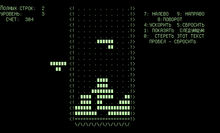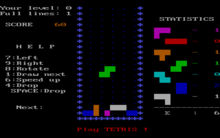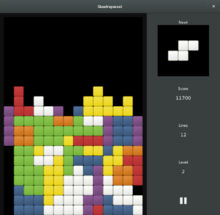Tetris
From Wikipedia, the free encyclopedia

Tetris is a Soviet tile-matching puzzle video game originally designed and programmed by Alexey Pajitnov. It was released on June 6, 1984, while he was working for the Dorodnicyn Computing Centre of the Academy of Science of the USSR in Moscow. He derived its name from the Greek numerical prefix tetra- (all of the game's pieces contain four segments) and tennis, Pajitnov's favorite sport.
It is also the first entertainment software to be exported from the USSR to the US and published by Spectrum HoloByte for Commodore 64 and IBM PC. The Tetris game is a popular use of tetrominoes, the four-element special case of polyominoes. Polyominoes have been used in popular puzzles since at least 1907, and the name was given by the mathematician Solomon W. Golomb in 1953. However, even the enumeration of pentominoes is dated to antiquity.
The game (or one of its many variants) is available for nearly every video game console and computer operating system, as well as on devices such as graphing calculators, mobile phones, portable media players, PDAs, Network music players and even as an Easter egg on non-media products like oscilloscopes. It has even inspired Tetris serving dishes and been played on the sides of various buildings.

While versions of Tetris were sold for a range of 1980s home computer platforms as well as the arcades, it was the hugely successful handheld version for the Game Boy launched in 1989 that established the game as one of the most popular ever. Electronic Gaming Monthly's 100th issue had Tetris in first place as "Greatest Game of All Time". In 2007, Tetris came in second place in IGN's "100 Greatest Video Games of All Time". In January 2010, it was announced that Tetris had sold more than 170 million copies, approximately 70 million physical copies and over 100 million copies for cell phones, making it the highest paid-downloaded game of all time.
On 16 March 2014 Tetris featured in the Sochi 2014 Paralympic Games closing ceremony where a huge colourful game of tetris was played on the stadium floor and the Tetris cubes spelling out the word impossible.
Gameplay
Tetriminos are game pieces shaped like tetrominoes, geometric shapes composed of four square blocks each. A random sequence of Tetriminos fall down the playing field (a rectangular vertical shaft, called the "well" or "matrix"). The objective of the game is to manipulate these Tetriminos, by moving each one sideways and rotating it by 90 degree units, with the aim of creating a horizontal line of ten blocks without gaps. When such a line is created, it disappears, and any block above the deleted line will fall. When a certain number of lines are cleared, the game enters a new level. As the game progresses, each level causes the Tetriminos to fall faster, and the game ends when the stack of Tetriminos reaches the top of the playing field and no new Tetriminos are able to enter. Some games also end after a finite number of levels or lines.
All of the Tetriminos are capable of single and double clears. I, J, and L are able to clear triples. Only the I Tetrimino has the capacity to clear four lines simultaneously, and this is referred to as a "tetris". (This may vary depending on the rotation and compensation rules of each specific Tetris implementation. For instance, in the Super Rotation System used in most recent implementations, certain situations allow T, S, and Z to 'snap' into tight spots and clear triples.)
History

Tetris has been involved in many legal battles in regard to rights ownership. In June 1984, Alexey Pajitnov created Tetris on an Elektronika 60 while working for the Soviet Academy of Sciences at their Computer Center in Moscow with Dmitry Pavlovsky, and Vadim Gerasimov ported it to the IBM PC. Gerasimov reports that Pajitnov chose the name "Tetris" as "a combination of 'tetromino' and 'tennis'." From there, the PC game exploded into popularity, and began spreading all around Moscow. The most recent version of this port is available on Gerasimov's web site.
The IBM PC version eventually made its way to Budapest, Hungary, where it was ported to various platforms and was "discovered" by a British software house named Andromeda. They attempted to contact Pajitnov to secure the rights for the PC version, but before the deal was firmly settled, they had already sold the rights to Spectrum HoloByte. After failing to settle the deal with Pajitnov, Andromeda attempted to license it from the Hungarian programmers instead.
Meanwhile, before any legal rights were settled, the Spectrum HoloByte IBM PC version of Tetris which contained background graphics featuring Russian scenes was released in the United States in 1987. The game's popularity was tremendous; Computer Gaming World called the game "deceptively simple and insidiously addictive".
The details of the licensing issues were uncertain by this point, but in 1987 Andromeda managed to obtain copyright licensing for the IBM PC version and any other home computer system. Their Commodore 64 release (1988) was notable for having a 26-minute (relatively long for the time) soundtrack composed by game musician Wally Beben.

For Amiga and Atari ST two different versions by Mirrorsoft (1987) and Spectrum Holobyte (1988) became available. The Mirrorsoft version did not feature any background graphics while the Spectrum Holobyte's version was similar to their PC version and contained the similar images (it was also distributed by Infogrames at some regions). Games were sold as budget titles due to the game's simplicity. Spectrum's Apple II package actually contained three diskettes with three different versions of the game, for the Apple II+ and Apple IIe on separate DOS 3.3 and ProDOS 5.25 in (133 mm) diskettes, and for the Apple IIgs on a 3.5 in (89 mm) diskette, none of which was copy-protected: the included documentation specifically charged the purchaser on his or her honor to not give away or copy the extra diskettes.
By 1988, the Soviet government began to market the rights to Tetris, after a promotional trip to the country by Gerald Hicks, the one time United States champion of the game, through an organization called Elektronorgtechnica, or "Elorg" for short. Pajitnov had granted his rights to the Soviet Government, via the Computer Center he had worked at for ten years. By this time, Elorg had still not been paid by Andromeda, and yet Andromeda was licensing and sub-licensing rights that they themselves did not even have. In the same year, an arcade version was released by Sega in Japan for the Sega's system 16 and system E. It won the Japanese Gamest Award for Game of the Year the following year. Tetris was also released in late 1988 by Bullet Proof Software (BPS) for several Japanese home computers as well as the MSX and the Family Computer in Japan. An unlicensed arcade version was released in Korea as well as an unlicensed Master System (titled Super Tetris (슈퍼 테트리스 Syupeo Teteuliseu).
By 1989, half a dozen different companies claimed rights to create and distribute the Tetris software for home computers, game consoles, and handheld systems. Elorg, meanwhile, held that none of the companies were legally entitled to produce an arcade version, and signed those rights over to Atari Games, while it signed non-Japanese console and handheld rights over to Nintendo. Tetris was on show at the January 1988 Consumer Electronics Show in Las Vegas, where it was picked up by Dutch games publisher Henk Rogers, then based in Japan, which eventually led to an agreement brokered with Nintendo that saw Tetris bundled with every Game Boy.
Tengen (the console software division of Atari Games), regardless, applied for copyright for their Tetris game for the Nintendo Entertainment System, loosely based on the arcade version, and proceeded to market and distribute it under the name TETЯIS: The Soviet Mind Game (with faux Cyrillic typography incorporating the Cyrillic letter Ya), disregarding Nintendo's license from Elorg. Nintendo contacted Atari Games claiming they had stolen rights to Tetris, whereupon Atari Games sued, believing they had the rights. After only four weeks on the shelf, the courts ruled that Nintendo was the only company which had the rights to Tetris on home game systems. Tengen's TETЯIS was recalled with an unknown number of copies sold. The lawsuits between Tengen and Nintendo over the NES version carried on until 1993.
Nintendo released their version of Tetris for both the NES and the Game Boy (both versions were developed by Bullet-Proof Software, Inc., who held the Japanese license, despite Nintendo's overseas license to the game); The NES version sold 8 million copies worldwide. Nintendo's NES version lacked the side-by-side 2-player option featured in Tengen's version. It was featured in Nintendo's Game Boy Tetris and it became arguably the most well-known version of Tetris, selling over 33 million copies, as it was bundled with Game Boy when it was released. Nintendo reviewed its version in the November/December 1989 edition of Nintendo Power.

Sega released a Tetris game for the Japanese Mega Drive similar to their arcade release; however, the ensuing blitz of litigation ensured that it was hastily withdrawn. It is estimated that only between 3 to 8 copies were produced.
In 1996, the rights to the game reverted from the Russian state to Pajitnov himself, who previously had made very little money from the game. In 1996, The Tetris Company was founded, claiming to hold copyright registrations for Tetris products in the U.S. and taking out trademark registrations for Tetris in almost every country in the world. They have licensed the brand to a number of companies, and the U.S. Court of International Trade and the U.S. Customs have at times issued seizure orders to preclude unlicensed Tetris-like games from being imported into the U.S., though bulletins circulated by the U.S. Copyright Office state that copyright does not apply to the rules of a game.
In mid-2006, and in late 1997, TTC's legal counsel sent cease and desist letters to Web sites on the basis of Tetris-type games infringing the "Tetris" trademark, trade dress, and/or "look and feel" copyright. Around 2009, TTC and Tetris Holding LLC brought legal action against BioSocia, Inc., on the grounds that BioSocia's "Blockles" game infringed on proprietary rights that were held by TTC and Tetris Holding LLC. On September 10, 2009, the legal case against BioSocia was resolved, with BioSocia agreeing to discontinue making the "Blockles" game available to the public. In May 2010, TTC's legal counsel sent cease and desist letters to Google insisting that 35 Tetris clones be removed from the Android Market. A US District Court judge ruled in June 2012 that the Tetris clone "Mino" from Xio Interactive infringed on the Tetris Company's copyrights by replicating such elements as the playfield dimensions and the shapes of the blocks.